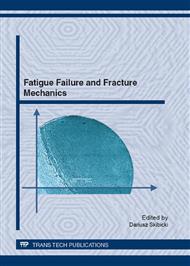p.181
p.189
p.195
p.203
p.211
p.218
p.222
p.226
p.233
An Experimental Investigation on Crack Initiation and Growth in Aircraft Fuselage Riveted Lap Joints
Abstract:
Effects of variables related to design and production of riveted lap joints representative of longitudinal sheet connections for a pressurized transport aircraft fuselage were experimentally investigated. The specimens from an aircraft Al alloy D16 Alclad sheets of three different thicknesses (1.9, 1.2 and 0.8 mm) were assembled under load control using round head rivets and rivets with the compensator from a P24 Al alloy. For the joints from 1.9 mm thick sheets fatigue tests indicated a dependency of the crack initiation site and crack path on the squeeze force level and on the rivet type. At the same time, increasing the squeeze force led to improved fatigue properties of the joints, specimens assembled using the rivets with the compensator showing fatigue lives consistently longer than joints with the round head rivets. All observed trends have been explained based on hole expansion and load transfer measurements. For thin sheets connected using the round head rivets, local deformations and indentations under the driven rivet head promoted crack initiation and failure in the adjacent sheet. Fatigue test results indicated that the detrimental effect of this type imperfections could outweigh the benefits associated with a decrease in secondary bending due to thinning the sheets. The rivets with the compensator were observed to cause significant local imperfections beneath the manufactured head, which adversely affected the joint fatigue performance.
Info:
Periodical:
Pages:
211-217
Citation:
Online since:
August 2012
Keywords:
Price:
Сopyright:
© 2012 Trans Tech Publications Ltd. All Rights Reserved
Share:
Citation:


